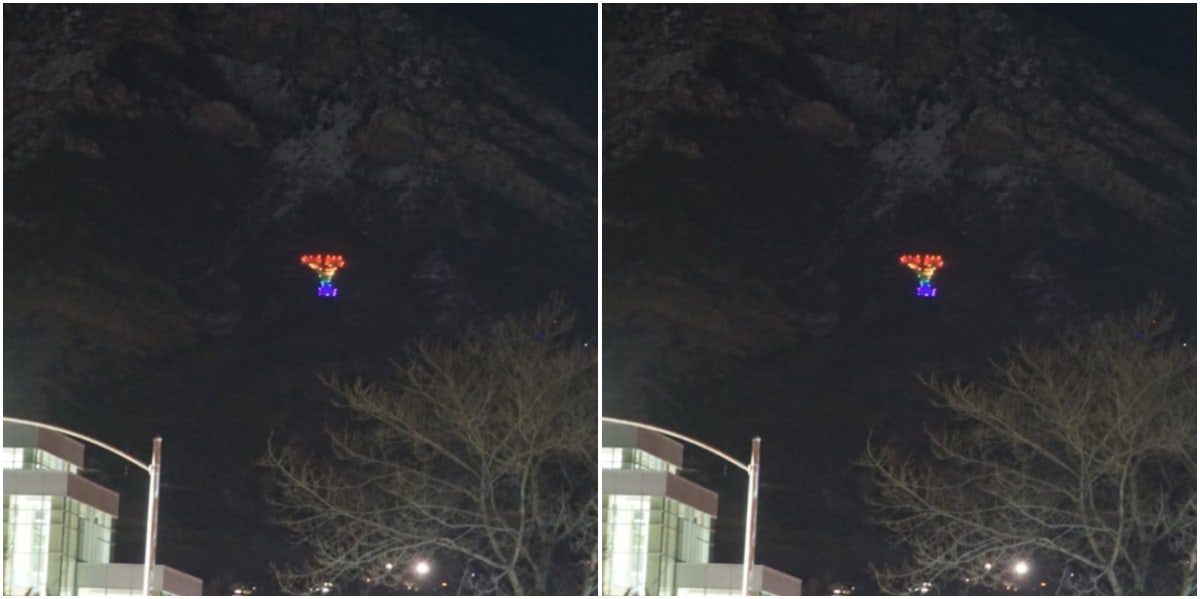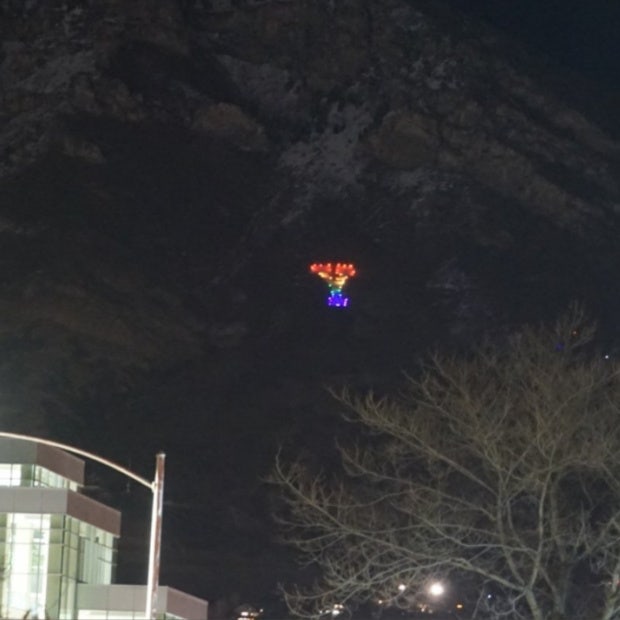We Spoke With One Of The BYU Students Who Lit Up The 'Y' With Rainbow Pride
What an inspiring act of defiance.
 Color The Campus
Color The Campus In an inspiring act of defiance against restrictive rules about LGBTQ expression, BYU students illuminated the ‘Y’ overlooking their campus in rainbow colors.
Brigham Young University in Provo is privately owned by the Utah-based Church of Jesus Christ of Latter-day Saints, or LDS Church, the religious group commonly referred to as Mormons.
Known for its oppressive rules around LGBTQ expression, the college has a history of trying to silence students and prevent any kind of same-sex interactions.
However, the events of March 4 show that, even if campus officials would rather believe otherwise, LGBTQ students exist — and thrive — at BYU.
We spoke with Bradley Talbot, the gay-identifying BYU student who launched his Color The Campus initiative in 2019 to show support for the LGBTQ+ community, about what happened with the lighting of the "Y" — and why.
Why did students at BYU light up the "Y" in rainbow colors?
The display, which was planned by a group of LGBT students and allies, illuminated the dark mountains surrounding the Provo campus to resist queer erasure from the college.
Talbot was part of the group of 40 students responsible for lighting the ‘Y,’ which he says was about creating a positive display rather than inciting trouble.
“We wanted to create a display that would have a lasting impact that also would not vandalize or disrupt campus,” Talbot tells us.
The students chose the date to mark the one-year anniversary of BYU sending out a deeply upsetting letter that reinstated the college’s anti-LGBTQ stance.
In 2020, LGBTQ students had welcomed the college’s decision to remove a section from their Honor Code banning "all forms of physical intimacy that give expression to homosexual feelings.”
This change encouraged students to come out publicly for the first time on campus and take photos of same-sex couples kissing in front of university landmarks.
The students had initially believed BYU was finally beginning to soften their oppressive rules, but their joy was quickly diminished when the college clarified that their still largely homophobic stance.
"One change to the Honor Code language that has raised questions was the removal of a section on 'Homosexual Behavior.' The moral standards of the Church did not change with the recent release of the General Handbook or the updated Honor Code, " the school's statement read.
"Same-sex romantic behavior cannot lead to eternal marriage and is therefore not compatible with the principles included in the Honor Code," it continued.
Talbot tells us that the lack of clarity makes the community vulnerable on campus, as there is no clear line explaining how they can or cannot express themselves.
“It is very confusing for LGBTQ+ students and we still don't fully know what is allowed or not,” he says.
This also creates an environment where those with anti-LGBTQ views are more likely to target members of the community.
“Those that are not affirming tend to feel more comfortable expressing their views which can be hurtful,” Talbot says.
The LDS Church has a long history of being anti-LGBT.
The Church doesn't allow same-sex marriage or any kind of same-sex sexual activity.
This means LGBTQ-identifying members of the Church are forced to either “change” their sexual orientation or live a celibate lifestyle, making the culture of the Church deeply unhealthy and damaging for these members.
The decision to light up the ‘Y’ in colors reflecting the LGBTQ Pride flag was a way for students to reclaim this day and translate what had been a traumatic event into something hopeful by defiantly telling Provo that LGBTQ people continue to exist in spite of the “rules.”
 Photo courtesy Color The Campus
Photo courtesy Color The Campus
BYU’s official stance remains predominately anti-LGBTQ.
They even condemned the lighting of the ‘Y’ publicly in a tweet following the event.
Talbot says the school administration's hardline attitude does not reflect the changing attitudes of many students and faculty at the college.
“I think we are seeing that there are more allies at BYU than we once thought and good change is coming,” he tells us.
Talbot says that representation is vital for the LGBTQ community who has a long history of being silenced.
He tells us that being a BYU student whilst also being part of a wider LGBTQ community is complex, but emphasizes that it is important to recognize how many people want to live proudly on campus.
“Recent studies have shown that about 13% of BYU students are LGBTQ+,” Talbot tells us,
“If we are to show that we love and care for these students, we need to give them representation. For many, this is a matter of life and death.”
Alice Kelly is a writer living in Brooklyn, New York. Catch her covering all things social justice, news, and entertainment.

